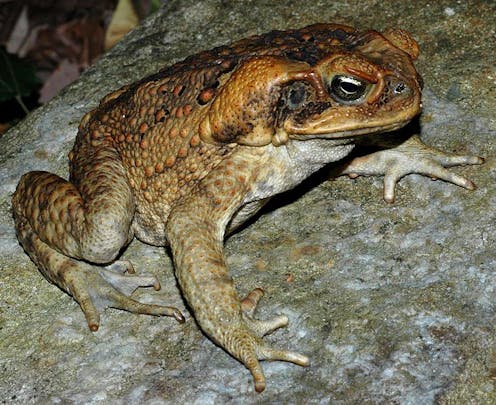We've cracked the cane toad genome, and that could help put the brakes on its invasion
- Written by Peter White, Professor in Microbiology and Molecular Biology, UNSW

We and our international colleagues have deciphered the genetic code of the cane toad. The complete sequence, published today in the journal GigaScience, will help us understand how the toad can quickly evolve to adapt to new environments, how its infamous toxin works, and hopefully give us new options for halting this invader’s march across Australia.
Since its introduction into Queensland in 1935, the cane toad has spread widely and now occupies more than 1.2 million square kilometres of Australia. It is fatally poisonous to predators such as the northern quoll, freshwater crocodiles, and several species of native lizards and snakes.
Previous attempts to sequence the cane toad, by WA researchers more than 10 years ago, were not successful, largely because the existing technology could not assemble the genetic pieces to create a genome. But thanks to new methods, we have succeeded in piecing together the entire genetic sequence.
Read more: Yes, you heard right: more cane toads really can help us fight cane toads
Our team, which also featured researchers from Portugal and Brazil, worked at the Ramaciotti Centre for Genomics at UNSW. This centre played a key role in decoding the genomes of other iconic Australian species, including the koala.
Sequencing, assembling and annotating a genome (working out which genes go where) is a complicated process. The cane toad genome is similar in size to that of humans, at roughly 3 billion DNA “letters”. By using cutting-edge technology, our team sequenced more than 360 billion letters of cane toad DNA code, and then assembled these overlapping pieces to produce one of the best-quality amphibian genomes to date.
We deduced more than 90% of the cane toad’s genes using technology that can sequence very long pieces of DNA. This made the task of putting together the genome jigsaw much easier.
Toxic toads
The cane toad has iconic status in Australia, with many Aussies loving to hate the poisonous invasive amphibian. This is a little unfair. It’s not the cane toad’s fault – it was humans who chose to bring it to Australia.
Our obsession with sugar in the 1800s led to the toad’s introduction to many countries around the world. Wherever sugar cane was planted, the cane toad followed, taken from plantation to plantation by landowners as the warty interlopers travelled from South America to the Caribbean and then on to Hawaii and Australia.
But unlike most other places to which the cane toad was introduced, Australia lacks any native toads of its own. The cane toad’s powerful poisons are deadly to native species that have never before encountered this amphibian’s arsenal.
The cane toad has therefore been subject to detailed evolutionary and ecological research in Australia, revealing not only its impact but also its amazing capacity for rapid evolution. Within 83 years of its introduction, cane toads in Australia have evolved a wide range of modifications that affect their body shape, physiology and behaviour.
For example, cane toads at the invasion front are longer-legged and bolder than those in long-colonised areas and invest less into their immune defences (for a summary, see Cane Toad Wars by Rick Shine).
The new genome will give us insights into how evolution transformed a sedentary amphibian into a formidable invasion machine. And it could give us new weapons to help stop, or at least slow, this invasion.
Cracking the cane toad genome.Viral control
Current measures such as physical removal have not been successful in preventing cane toads from spreading, so fresh approaches are needed. One option may be to use a virus to help control the toad population.
Viruses such as myxomatosis have been successfully used to control rabbits. But the cane toad viruses studied so far are also infectious to native frogs. The new genome could potentially help scientists hunt for viruses that attack only toads.
In a study published this month, we and other colleagues describe how we sampled genetic sequences from cane toads from different Australian locations, and found three viruses that are genetically similar to viruses that infect frogs, reptiles and fish. These viruses could potentially be used as biocontrol agents, although only after comprehensive testing to check that they pose no danger to any other native species.
Read more: Come hither... how imitating mating males could cut cane toad numbers
The full cane toad genome will help to accelerate this kind of research, as well as research on the toads’ evolution and its interactions with the wider ecosystem. The published sequence is freely available for anyone to use in their studies. It is one of very few amphibian genomes sequenced so far, so this is also great news for amphibian biologists in general.
As the cane toads continue their march across the Australian landscape, this milestone piece of research should help us put a few more roadblocks in their path.
Authors: Peter White, Professor in Microbiology and Molecular Biology, UNSW




